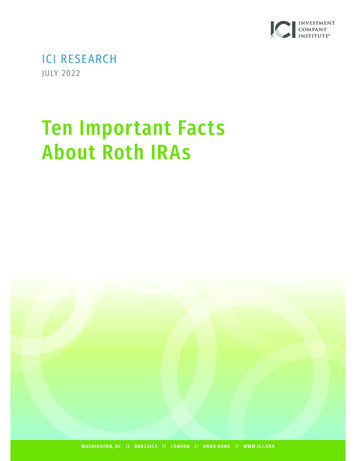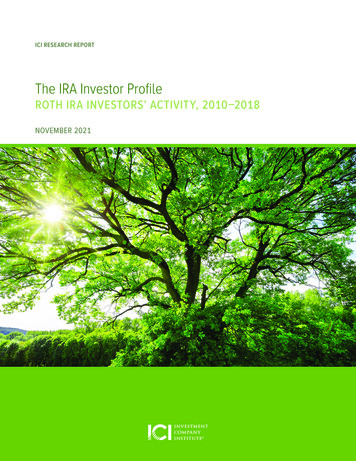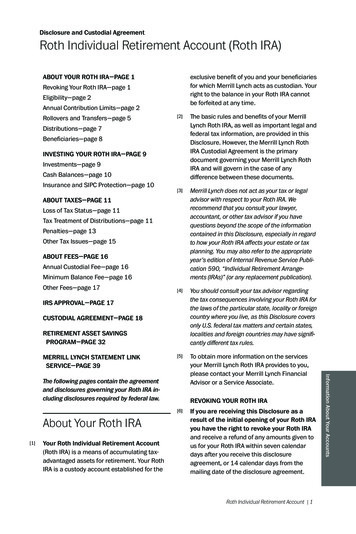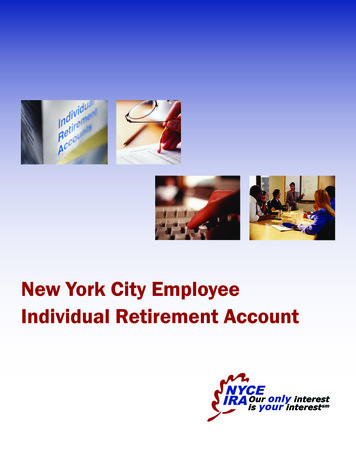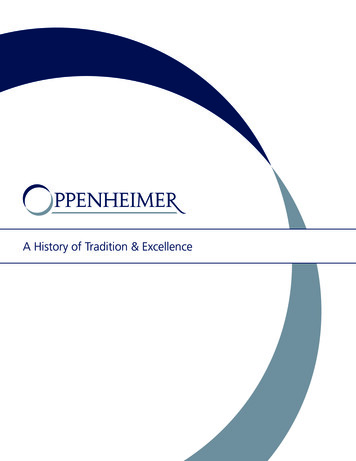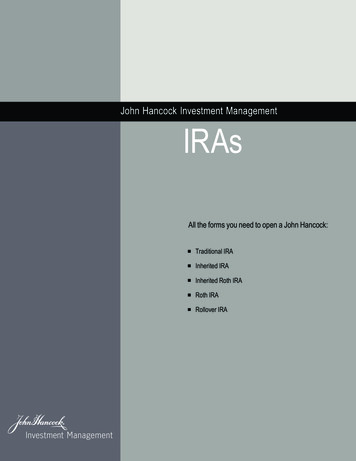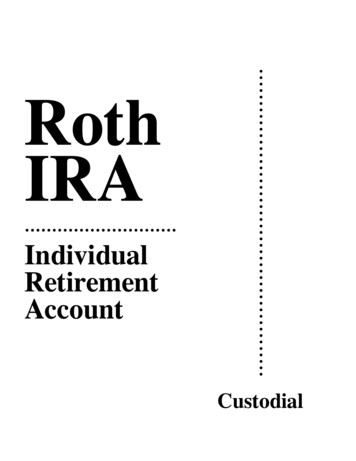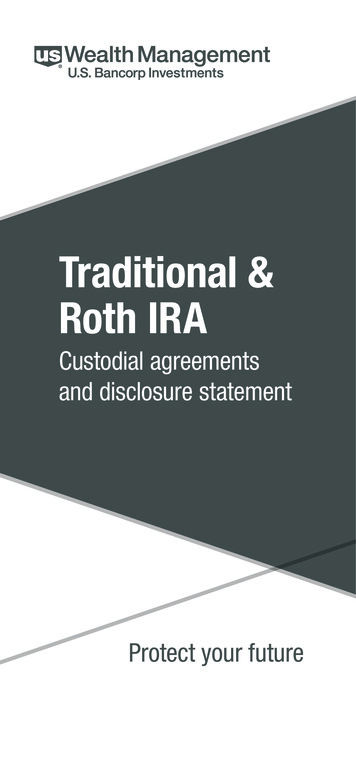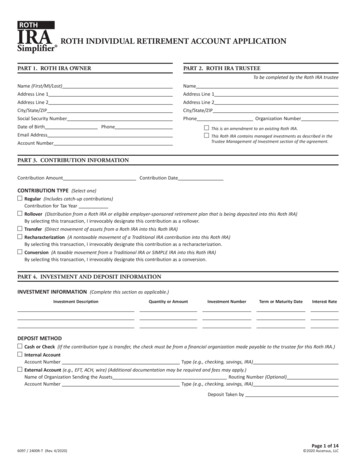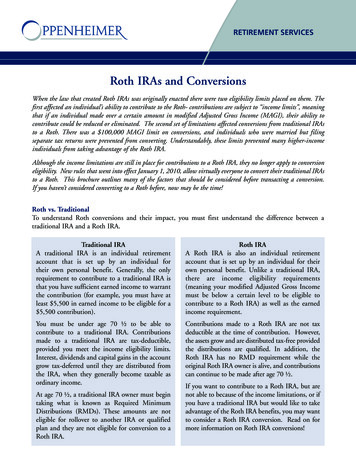
Transcription
RETIREMENT SERVICESRoth IRAs and ConversionsWhen the law that created Roth IRAs was originally enacted there were two eligibility limits placed on them. Thefirst affected an individual’s ability to contribute to the Roth- contributions are subject to “income limits”, meaningthat if an individual made over a certain amount in modified Adjusted Gross Income (MAGI), their ability tocontribute could be reduced or eliminated. The second set of limitations affected conversions from traditional IRAsto a Roth. There was a 100,000 MAGI limit on conversions, and individuals who were married but filingseparate tax returns were prevented from converting. Understandably, these limits prevented many higher-incomeindividuals from taking advantage of the Roth IRA.Although the income limitations are still in place for contributions to a Roth IRA, they no longer apply to conversioneligibility. New rules that went into effect January 1, 2010, allow virtually everyone to convert their traditional IRAsto a Roth. This brochure outlines many of the factors that should be considered before transacting a conversion.If you haven’t considered converting to a Roth before, now may be the time!Roth vs. TraditionalTo understand Roth conversions and their impact, you must first understand the difference between atraditional IRA and a Roth IRA.Traditional IRAA traditional IRA is an individual retirementaccount that is set up by an individual fortheir own personal benefit. Generally, the onlyrequirement to contribute to a traditional IRA isthat you have sufficient earned income to warrantthe contribution (for example, you must have atleast 5,500 in earned income to be eligible for a 5,500 contribution).Roth IRAA Roth IRA is also an individual retirementaccount that is set up by an individual for theirown personal benefit. Unlike a traditional IRA,there are income eligibility requirements(meaning your modified Adjusted Gross Incomemust be below a certain level to be eligible tocontribute to a Roth IRA) as well as the earnedincome requirement.You must be under age 70 ½ to be able tocontribute to a traditional IRA. Contributionsmade to a traditional IRA are tax-deductible,provided you meet the income eligibility limits.Interest, dividends and capital gains in the accountgrow tax-deferred until they are distributed fromthe IRA, when they generally become taxable asordinary income.Contributions made to a Roth IRA are not taxdeductible at the time of contribution. However,the assets grow and are distributed tax-free providedthe distributions are qualified. In addition, theRoth IRA has no RMD requirement while theoriginal Roth IRA owner is alive, and contributionscan continue to be made after age 70 ½.At age 70 ½, a traditional IRA owner must begintaking what is known as Required MinimumDistributions (RMDs). These amounts are noteligible for rollover to another IRA or qualifiedplan and they are not eligible for conversion to aRoth IRA.If you want to contribute to a Roth IRA, but arenot able to because of the income limitations, or ifyou have a traditional IRA but would like to takeadvantage of the Roth IRA benefits, you may wantto consider a Roth IRA conversion. Read on formore information on Roth IRA conversions!1
RETIREMENT SERVICESWhat is a Roth IRA Conversion?A Roth conversion is completed when a traditional IRA owner moves his or her traditional IRA assets into aRoth IRA. In addition, qualified plan (pension, 401(k), profit sharing, etc.) participants may elect to converttheir assets to a Roth IRA.What assets are eligible for conversion?Generally, all traditional IRA, rollover IRA, SEP IRA, and SIMPLE IRA (after meeting the two-year holdingperiod) assets are eligible for conversion. In addition, most 401(k), 403(b), profit sharing and pension assetsare also eligible for conversion when they are able to be distributed from the plan and do not consist ofRequired Minimum Distribution (RMD) amounts.Beneficiaries inheriting qualified plan assets also have the unique opportunity to convert the qualified planassets to a beneficiary Roth IRA. Unfortunately, this option is not available to those non-spouse individualswho are inheriting traditional IRA assets. In addition, non-spouse beneficiaries who have inherited qualifiedplan assets can only convert those assets to a beneficiary Roth IRA through a direct trustee to trustee rolloverconversion (the assets being converted must be rollover eligible and cannot consist of RMDs).Is a Conversion Right For You?Before transacting a conversion, there are some things you should consider: Can you afford to pay the conversion tax?Pre-tax amounts that you convert to a Roth IRA must be included in income, and are generally subjectto income taxation. If you use your IRA assets to pay the conversion taxes, you are depleting the benefitsof your IRA. Additionally, if you are under age 59 ½, you will owe taxes and penalties on the amountused to pay the tax. If you cannot afford to pay the tax due on a conversion, a conversion may not beright for you. What tax bracket will you be in during the year of conversion versus the tax bracket you expect to be inwhen you begin distributions from your Roth IRA?If you will be in a higher tax bracket when you need to access your IRA assets, a Roth IRA conversioncould help you by “charging” the conversion income tax now, while you’re in your lower tax-bracket, andallowing for tax-free distributions when you need access to the funds and are in a higher tax bracket. Keepin mind that the amount converted may put you into a higher tax bracket. Would you like to avoid taking RMDs after reaching age 70 ½?If you are approaching RMD age, but don’t want or need to take distributions from your IRA, a Roth IRAcan solve your problem! Unlike traditional IRAs, there is no RMD requirement from a Roth IRA whilethe original account holder is still alive, and there is no age restriction on the ability to make contributions.In addition, a spousal beneficiary is generally not required to take RMDs either. What type of estate considerations do you have and who do you want the IRA to benefit (you oryour beneficiaries)?If you are looking to reduce the value of your estate so that you can pass on more substantial assets to yourbeneficiaries, then a Roth IRA may help you achieve this goal by incurring the conversion tax now (therebyreducing the value of your current assets) and allowing you to pass on a potentially large income tax-freeaccount to your heirs. In addition, since there are no RMDs required, your IRA would be able to groweven larger- all tax-free for your heirs.2
RETIREMENT SERVICESKeeping those considerations in mind, those who might consider converting to a Roth IRA wouldgenerally be: Individuals age 70 ½ and older who would like to reduce or eliminate future traditional IRA RMDs duringtheir lifetime. Individuals who prefer to pay tax now, rather than later, such as those individuals who will pay income taxat the same or higher rate when withdrawals begin from their retirement accounts. Taxpayers with after-tax amounts in their IRA. After-tax amounts converted from a traditional IRA to aRoth IRA are generally not subject to income tax. Distributions from any traditional IRA are a pro-ratareturn of after-tax amounts.Conversions of After-Tax Assets in a Traditional IRAIf you have both pre-tax and after-tax assets in your traditional IRA, you cannot convert only after-tax assetsto a Roth IRA. The conversion amount will consist of a pro-rata portion of pre-tax and after-tax assets. Alltraditional IRA assets of an individual must be aggregated to determine the pro-rata formula.What Are the Potential Drawbacks of a Conversion?A conversion is not right for everyone and the decision to convert should not be taken lightly. Generally, theprincipal drawback to converting to a Roth IRA is that you must include the pre-tax amounts in income inthe year that you convert. If your tax rate will drop in retirement, a conversion may not be in your bestinterest. In order for all distributions to be taken out tax and penalty free, you must meet a five-year holdingrequirement and you must be at least age 59 ½ or have a qualifying distribution reason.Roth IRA Distribution RulesIf you are wondering how soon you will be able to take distributions from your Roth IRA, you should beaware of the somewhat complex Roth IRA distribution rules.How soon can assets be withdrawn?You can withdraw money from a Roth IRA at any time. You may owe taxes and/or penalties if you make anon-qualified distribution. A distribution is considered “qualified” (and therefore is tax and penalty free) ifyou have maintained a Roth IRA for at least five years and you are age 59 ½ or older. If you are not age 59½ or older, but the distribution is being made due to a qualified disability, is made to a beneficiary or to theestate after the death of the IRA owner, or is made for the qualified purchase of a first-home (up to 10,000),then the distribution can still be a “qualified distribution”, provided the 5-year holding period is met.Non-qualified distributions may be subject to tax or penalty depending on what is distributed. In a RothIRA, distributions are made up of contribution amounts first, then conversion amounts on a first-in first-outbasis, and then account earnings.3
RETIREMENT SERVICESBelow is a simplified chart that outlines the basic Roth IRA distribution rules*.Order of Distribution TakenAge of Account Owner When Distribution is TakenUnder 59 ½Over 59 ½Contributions:Income tax-freePenalty-freeIncome tax-freePenalty-freeConversions**:(applies to eachconversion separately)Income tax-free10% penalty may apply if within5-year holding periodIncome tax-freeNo 10% penaltyEarnings:Taxable as income if distributionis non-qualified10% penalty may applyTaxable as income if within5-year holding periodNo 10% penalty*This table is a simplified outline used to illustrate how some Roth IRA distributions may be taxed and penalized. There are other possible exceptions tothe 10% penalty that are not illustrated in this chart. For more information on distributions from a Roth IRA, please request Oppenheimer’s “Roth IRADistributions: A General Overview” marketing piece from your Financial Advisor. Roth IRA distribution information can also be found in IRSPublication 590.**Please note that each conversion contribution has a separate 5-year holding period that must be met for a distribution to be a qualified distribution.Planning Tips!Be aware of your tax bracket!When considering a Roth IRA conversion, it is very important to be aware of your current tax bracket andhow the resulting conversion income may affect your bracket. A conversion can take you into a different taxbracket negating the economic benefit of a conversion for some! If you are an older individual, it is alsoimportant to recognize that increasing your income could affect your social security or Medicarequalifications and/or payments.Partial ConversionsIf you do not want to convert 100% of your traditional IRA or qualified plan to a Roth IRA, then you can transacta partial conversion. A partial conversion is when an individual converts only a portion of their traditional IRAor qualified plan to a Roth IRA. This strategy may be helpful in keeping your tax liability relatively low.Changed your mind? Consider a recharacterization!If you have converted all, or a portion of your traditional IRA or qualified plan to a Roth IRA, and then find thatit was not in your best interest to do so, you can effectively “reverse” that decision through a recharacterization.A recharacterization allows you to treat a contribution made to one type of IRA as having been made to adifferent type of IRA (i.e., from a Roth IRA to a traditional IRA). A recharacterization must be completedby your tax filing deadline, including extensions.This strategy could be helpful if: Your account value drops. In this scenario, you may want to recharaterize your conversion and then reconvert, so that you can pay taxes on a smaller account value. You find your tax bracket is higher than you expected, making a conversion less appealing.It is important to note that if you convert, and then recharacterize that conversion, you cannot reconvert those assetsuntil the later of 30-days after the recharacterization or the calendar year following the conversion.4
RETIREMENT SERVICESConverting different assets?If you have multiple assets that you would like to convert, one strategy is to convert each asset class into aseparate Roth IRA so that if the value of one asset dips, you can recharacterize just the Roth that has decreasedin value, this way you may realize less taxable income.For example, let’s say that you have a traditional IRA that is invested in 250,000 each of equities, bonds,and cash equivalent investments, and you want to convert your entire IRA into a Roth. You convert 250,000 of equities into one Roth IRA (1), 250,000 of bonds into another Roth IRA (2), and 250,000of cash equivalents into a third Roth IRA (3). Then, in December of the year of conversion, you find thatthe 250,000 of bonds has decreased to 200,000 while the other two Roths have increased in value. At thatpoint, you can recharacterize Roth IRA (2) and keep the Roth IRA (1) and (3) as-is. After 30 days, you canthen reconvert back to a Roth IRA*.Remember that the income tax on the conversion is based upon the value of the assets converted on theiractual date of conversion. Therefore, if that value dips you are paying tax on the higher amount. Arecharacterization allows you to avoid paying tax on the higher account value.*Note- because the client in this example did a recharacterization in December, the 30-day period following therecharacterization will fall in the next tax year so the client only has to wait 30-days to reconvert.Personalized IllustrationYour Oppenheimer Financial Advisor can run a personalized illustration for you to show the possible benefitsof a Roth IRA conversion. This illustration can outline the impact that your decision could have on yourfuture taxes and on your beneficiaries.Contact your Oppenheimer & Co. Inc. Financial Advisor today for assistancewith your Roth IRA conversion needs!Oppenheimer & Co. Inc.85 Broad StreetNew York, NY 10004800-620-OPCO 212-668-8000www.opco.com 2014 Oppenheimer & Co. Inc. Transacts Business on All Principal Exchanges and Member SIPC. All Rights Reserved.The information contained herein is general in nature, has been obtained from various sources believed to be reliable and is subjectto changes in the Internal Revenue Code, as well as other areas of law. Oppenheimer & Co. Inc. does not provide legal or tax advice.Please contact your legal or tax advisor for specific advice regarding your circumstances.No part of this brochure may be reproduced in any manner without the written permission of Oppenheimer & Co. Inc.RS012610RM1
the 10% penalty that are not illustrated in this chart. For more information on distributions from a Roth IRA, please request Oppenheimer's "Roth IRA Distributions: A General Overview" marketing piece from your Financial Advisor. Roth IRA distribution information can also be found in IRS Publication 590.

